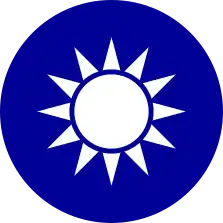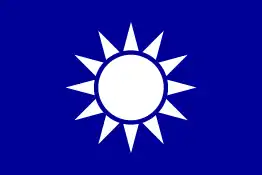History of the Kuomintang
The History of the Kuomintang is an article on the inception of the Kuomintang (KMT or CNP;), a Chinese political party that ruled China 1927–48 and then moved to Taiwan. The name translates as "China's National People's Party" and was historically referred to as the Chinese Nationalists. The Party was initially founded on 23 August 1912, by Sun Yat-sen but dissolved in November 1913. It reformed on October 10th 1919, again led by Sun Yat-sen, and became the ruling party in China. After Sun's death, the party was dominated from 1927 to 1975 by Chiang Kai-shek. Though the KMT lost the civil war with the Communist Party of China in 1949, the party took control of Taiwan and remains a major political party of the Republic of China based in Taiwan.
 | ||||||||
|---|---|---|---|---|---|---|---|---|
| ANCIENT | ||||||||
| Neolithic c. 8500 – c. 2070 BCE | ||||||||
| Xia c. 2070 – c. 1600 BCE | ||||||||
| Shang c. 1600 – c. 1046 BCE | ||||||||
| Zhou c. 1046 – 256 BCE | ||||||||
| Western Zhou | ||||||||
| Eastern Zhou | ||||||||
| Spring and Autumn | ||||||||
| Warring States | ||||||||
| IMPERIAL | ||||||||
| Qin 221–207 BCE | ||||||||
| Han 202 BCE – 220 CE | ||||||||
| Western Han | ||||||||
| Xin | ||||||||
| Eastern Han | ||||||||
| Three Kingdoms 220–280 | ||||||||
| Wei, Shu and Wu | ||||||||
| Jin 266–420 | ||||||||
| Western Jin | ||||||||
| Eastern Jin | Sixteen Kingdoms | |||||||
| Northern and Southern dynasties 420–589 | ||||||||
| Sui 581–618 | ||||||||
| Tang 618–907 | ||||||||
| (Wu Zhou 690–705) | ||||||||
| Five Dynasties and Ten Kingdoms 907–979 |
Liao 916–1125 | |||||||
| Song 960–1279 | ||||||||
| Northern Song | Western Xia | |||||||
| Southern Song | Jin | Western Liao | ||||||
| Yuan 1271–1368 | ||||||||
| Ming 1368–1644 | ||||||||
| Qing 1636–1912 | ||||||||
| MODERN | ||||||||
| Republic of China on mainland 1912–1949 | ||||||||
| People's Republic of China 1949–present | ||||||||
| Republic of China on Taiwan 1949–present | ||||||||
Founded in 1912 by Sun Yat-sen, the KMT helped topple the Qing Emperor and promoted modernization along Western lines. The party played a significant part in the first Chinese first National Assembly where it was the majority party. However the KMT failed to achieve complete control. The post of president was given to Yuan Shikai (1859–1916) as reward for his part in the revolution. Yuan Shikai abused his powers, overriding the constitution and creating strong tensions between himself and the other parties. In July 1913, the KMT staged a 'Second Revolution' to depose Yuan. This failed and the following crack down by Yuan led to the dissolution of the KMT and the exile of its leadership, mostly to Japan. Subsequently, Yuan Shikai had himself made Emperor of China.
In exile, Sun Yat-sen and other former KMT members founded several revolutionary parties under various names but with little success. These parties were united by Sun in 1919 under the title "The Kuomintang of China". The new party returned to Guangzhou in China in 1920 where it set up a government but failed to achieve control of all of China. After the death of Yuan Shikai in 1916, China fractured into many regions controlled by warlords. To strengthen the party's position, it accepted aid and support from the Soviet Union and its Comintern. The fledgling Communist Party of China was encouraged to join the KMT and thus formed the First United Front. The KMT gradually increased its sphere of influence from its Guangzhou base. Sun Yat-sen died in 1925 and Chiang Kai-shek (1887–1975) became the KMT strong man. In 1926 Chiang led a military operation known as the Northern Expedition against the warlords that controlled much of the country. In 1927, Chiang instigated the April 12 Incident in Shanghai in which the Communist Party of China and Communist elements of the KMT were purged.[1] The Northern Expedition proved successful and the KMT party came to power throughout China (except Manchuria) in 1927 under the leadership of Chiang. The capital of China was moved to Nanjing in order to be closer to the party's strong base in southern China.
The party was always concerned with strengthening Chinese identity at the same time it was discarding old traditions in the name of modernity. In 1929, the KMT government suppressed the textbook Modern Chinese History, widely used in secondary education. The Nationalists were concerned that, by not admitting the existence of the earliest emperors in ancient Chinese history, the book would weaken the foundation of the state. The case of the Modern Chinese History textbook reflects the symptoms of the period: banning the textbook strengthened the Nationalists' ideological control but also revealed their fear of the New Culture Movement and its more liberal ideological implications. The KMT tried to destroy the Communist party of Mao Zedong, but was unable to stop the invasion by Japan, which controlled most of the coastline and major cities, 1937–1945. Chiang Kai-shek secured massive military and economic aid from the United States, and in 1945 became one of the five permanent members of the UN Security Council, with a veto. The KMT governed most of China until it was defeated in the civil war by the Communists in 1949.
The leadership, the remaining army, and hundreds of thousands of businessmen and other supporters, two million in all, fled to Taiwan. They continued to operate there as the "Republic of China" and dreamed of invading and reconquering what they called "Mainland China". The United States, however, set up a naval cordon after 1950 that has since prevented an invasion in either direction. The KMT regime kept the island under martial law for 38 years, killing up to 30,000 opponents during its dictatorial rule by Chiang Kai-shek and his son Chiang Ching-kuo (1910–1988). As the original leadership died off, it had to hold elections, allowed democracy, with full election of parliament in the early 1990s and first direct presidential election in 1996. After a defeat by the Democratic Progressive Party in 2000, the KMT returned to power in the elections of 2008 and 2012.
Early years
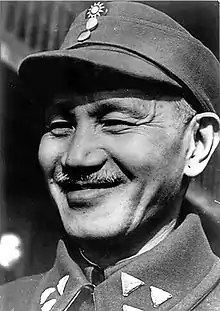
The Kuomintang traces its roots to the Revive China Society, which was founded in 1895 and merged with several other anti-monarchist societies as the Revolutionary Alliance in 1905. After the overthrow of the Qing Dynasty in the 1911 Xinhai Revolution and the founding of the Republic of China, the Kuomintang was formally established on 25 August 1912 at the Huguang Guild Hall in Beijing where the Revolutionary Alliance and several smaller revolutionary groups joined together to contest the first National Assembly elections.[2]
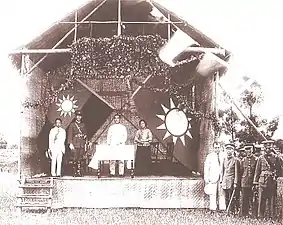
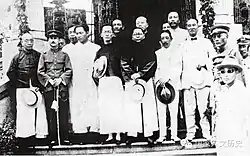
Sun Yat-sen, who had just stepped down as provisional president of the Republic of China, was chosen as its overall leader under the title of premier (Chinese: 總理; pinyin: zǒnglǐ), and Huang Xing was chosen as Sun's deputy. However, the most influential member of the party was the third ranking Song Jiaoren, who mobilized mass support from gentry and merchants for the KMT on a platform of promoting constitutional parliamentary democracy. Though the party had an overwhelming majority in the first National Assembly, President Yuan Shikai started ignoring the parliamentary body in making presidential decisions, counter to the Constitution, and assassinated its parliamentary leader Song Jiaoren in Shanghai in 1913. Members of the KMT led by Sun Yat-sen staged the Second Revolution in July 1913, a poorly planned and ill-supported armed rising to overthrow Yuan, and failed. Yuan dissolved the KMT in November (whose members had largely fled into exile in Japan) and dismissed the parliament early in 1914. Yuan Shikai proclaimed himself emperor in December 1915. While exiled in Japan in 1914, Sun established the Chinese Revolutionary Party, but many of his old revolutionary comrades, including Huang Xing, Wang Jingwei, Hu Hanmin and Chen Jiongming, refused to join him or support his efforts in inciting armed uprising against Yuan Shikai. In order to join the Chinese Revolutionary Party, members must take an oath of personal loyalty to Sun, which many old revolutionaries regarded as undemocratic and contrary to the spirit of the revolution. Thus, many old revolutionaries did not join Sun's new organization, and he was largely sidelined within the Republican movement during this period. Sun returned to China in 1917 to establish a rival government in Guangzhou, but was soon forced out of office and exiled to Shanghai. There, with renewed support, he resurrected the KMT on 10 October 1919, but under the name of the Chinese Kuomintang, as the old party had simply been called the Kuomintang. In 1920, Sun and the KMT were restored in Guangdong. In 1923, the KMT and its government accepted aid from the Soviet Union after being denied recognition by the western powers. Soviet advisers – the most prominent of whom was Mikhail Borodin, an agent of the Comintern – began to arrive in China in 1923 to aid in the reorganization and consolidation of the KMT along the lines of the Communist Party of the Soviet Union, establishing a Leninist party structure that lasted into the 1990s. The Chinese Communist Party (CCP) was under Comintern instructions to cooperate with the KMT, and its members were encouraged to join while maintaining their separate party identities, forming the First United Front between the two parties.
Soviet advisers also helped the Nationalists set up a political institute to train propagandists in mass mobilization techniques, and in 1923 Chiang Kai-shek, one of Sun's lieutenants from the Tongmenghui days, was sent to Moscow for several months' military and political study. At the first party congress in 1924, which included non-KMT delegates such as members of the CCP, they adopted Sun's political theory, which included the Three Principles of the People – nationalism, democracy, and people's livelihood.
War with Communists
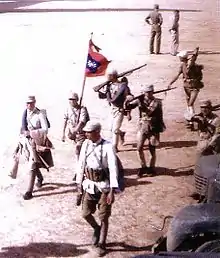
Following the death of Sun Yat-sen, General Chiang Kai-shek emerged as the KMT leader and launched the Northern Expedition in 1926 to defeat the northern warlords and unite China under the party. He halted briefly in Shanghai in 1927 to purge the Communists who had been allied with the KMT, which sparked the Chinese Civil War. When Kuomintang forces took Beijing, as the city was the de jure internationally recognized capital, though previously controlled by the feuding warlords, this event allowed the Kuomintang to receive widespread diplomatic recognition in the same year. The capital was moved from Beijing to Nanjing, the original capital of the Ming Dynasty, and thus a symbolic purge of the final Qing elements. This period of KMT rule in China between 1927 and 1937 became known as the Nanjing decade.
In sum, the KMT began as a heterogeneous group advocating American-inspired federalism and provincial independence. However, after its reorganization along Soviet lines, the party aimed to establish a centralized one-party state with one ideology – Three Principles of the People. This was even more evident following Sun's elevation into a cult figure after his death. The control by one single party began the period of "political tutelage," whereby the party was to control the government while instructing the people on how to participate in a democratic system. After several military campaigns and with the help of German military advisors (German planned fifth "extermination campaign"), the Communists were forced to withdraw from their bases in southern and central China into the mountains in a massive military retreat known famously as the Long March, an undertaking which would eventually increase their reputation among the peasants. Out of the 86,000 Communist soldiers that broke out of the pocket, only 20,000 would make the 10,000 km march to Shaanxi province. The Kuomintang continued to attack the Communists. This was in line with Chiang's policy of solving internal conflicts (warlords and communists) before fighting external invasions (Japan). However, Zhang Xueliang, who believed that the Japanese invasion constituted the greater prevailing threat, took Chiang hostage during the Xi'an Incident in 1937 and forced Chiang to agree to an alliance with the Communists in the total war against the Japanese. The Second Sino-Japanese War had officially started, and would last until the Japanese surrender in 1945. However, in many situations the alliance was in name only; after a brief period of cooperation, the armies began to fight the Japanese separately, rather than as coordinated allies. Conflicts between KMT and communists were still common during the war, and documented claims of Communist attacks upon the KMT forces, and vice versa, abound.
In these incidents, the KMT armies typically utilized more traditional tactics while the Communists chose guerilla tactics, leading to KMT claims that the Communists often refused to support the KMT troops, choosing to withdraw and let the KMT troops take the brunt of Japanese attacks. These same guerilla tactics, honed against the Japanese forces, were used to great success later during open civil war, as well as the Allied forces in the Korean War and the U.S. forces in the Vietnam War.
1945–49
Full-scale civil war between the Communists and KMT resumed after the defeat of Japan. The Communist armies, previously a minor faction, grew rapidly in influence and power due to several errors on the KMT's part: first, the KMT reduced troop levels precipitously after the Japanese surrender, leaving large numbers of able-bodied, trained fighting men who became unemployed and disgruntled with the KMT as prime recruits for the Communists.
Second, the collapse of the KMT regime can in part be attributed to the government's economic policies, which triggered capital flight among the businessmen who had been the KMT's strongest supporters. The cotton textile industry was the leading sector of Chinese industry, but in 1948, shortages of raw cotton plunged the industry into dire straits. The KMT government responded with an aggressive control policy that directly procured cotton from producers to ensure a sufficient supply and established a price freeze on cotton thread and textiles. This policy failed because of resistance from cotton textile industrialists, who relocated textile facilities and capital to Hong Kong or Taiwan around the end of 1948 and early 1949 when prices soared and inflation spiraled out of control. Their withdrawal of support was a shattering blow to the morale of the KMT.
Among the most despised and ineffective efforts it undertook to contain inflation was the conversion to the gold standard for the national treasury and the Gold Standard Script (Chinese: 金圓券; pinyin: jīn yuán quàn) in August 1948, outlawing private ownership of gold, silver, and foreign exchange, collecting all such precious metals and foreign exchange from the people and issuing the Gold Standard Script in exchange. The new script became worthless in only ten months and greatly reinforced the nationwide perception of KMT as a corrupt or at best inept entity. Third, Chiang Kai-shek ordered his forces to defend the urbanized cities. This decision gave the Communists a chance to move freely through the countryside. At first, the KMT had the edge with the aid of weapons and ammunition from the United States. However, with hyperinflation and other economic ills, widespread corruption, the KMT continued to lose popular support. At the same time, the suspension of American aid and tens of thousands of deserted or decommissioned soldiers being recruited to the Communist cause tipped the balance of power quickly to the Communist side, and the overwhelming popular support for the Communists in most of the country made it all but impossible for the KMT forces to carry out successful assaults against the Communists. By the end of 1949, the Communists controlled almost all of mainland China, as the KMT retreated to Taiwan with a significant amount of China's national treasures and 2 million people, including military forces and refugees. Some party members stayed in the mainland and broke away from the main KMT to found the Revolutionary Committee of the Kuomintang, which still currently exists as one of the eight minor registered parties in the People's Republic of China.
Ideology in Mainland China (1920s–1950s)
Chinese nationalism
The Kuomintang was a nationalist revolutionary party, which had been supported by the Soviet Union. It was organized on Leninism.[3]
The Kuomintang had several influences left upon its ideology by revolutionary thinking. The Kuomintang and Chiang Kai-shek used the words feudal and counterrevolutionary as synonyms for evil, and backwardness, and proudly proclaimed themselves to be revolutionary.[4][5] Chiang called the warlords feudalists, and called for feudalism and counterrevolutionaries to be stamped out by the Kuomintang.[6][7][8][9] Chiang showed extreme rage when he was called a warlord, because of its negative, feudal connotations.[10] Ma Bufang was forced to defend himself against the accusations, and stated to the news media that his army was a part of "National army, people's power".[11]
Chiang Kai-shek, the head of the Kuomintang, warned the Soviet Union and other foreign countries about interfering in Chinese affairs. He was personally angry at the way China was treated by foreigners, mainly by the Soviet Union, Britain, and the United States.[7][12] He and his New Life Movement called for the crushing of Soviet, Western, American and other foreign influences in China. Chen Lifu, a CC Clique member in the KMT, said "Communism originated from Soviet imperialism, which has encroached on our country." It was also noted that "the white bear of the North Pole is known for its viciousness and cruelty."[13]
The Blue Shirts Society, a fascist paramilitary organization within the Kuomintang modeled after Mussolini's blackshirts, was anti-foreign and anticommunist, and stated that its agenda was to expel foreign (Japanese and Western) imperialists from China, crush Communism, and eliminate feudalism.[14] In addition to being anticommunist, some Kuomintang members, like Chiang Kaishek's right-hand man Dai Li were anti-American, and wanted to expel American influence.[15]
Kuomintang leaders across China adopted nationalist rhetoric. The Chinese Muslim general Ma Bufang of Qinghai presented himself as a Chinese nationalist to the people of China, fighting against British imperialism, to deflect criticism by opponents that his government was feudal and oppressed minorities like Tibetans and Buddhist Mongols. He used his Chinese nationalist credentials to his advantage to keep himself in power.[16][17]
The Kuomintang pursued a sinicization policy, it was stated that "the time had come to set about the business of making all natives either turn Chinese or get out" by foreign observers of Kuomintang policy. It was noted that "Chinese colonization" of "Mongolia and Manchuria" led to the conclusion "to a conviction that the day of the barbarian was finally over."[18][19][20]
New Guangxi Clique
Dr. Sun Yat-sen, the founding father of the Republic of China and of the Kuomintang party praised the Boxers in the Boxer Rebellion for fighting against Western Imperialism. He said the Boxers were courageous and fearless, fighting to the death against the Western armies, Dr. Sun specifically cited the Battle of Yangcun.[21]
During the Northern Expedition, the Kuomintang incited anti-foreign, anti-western sentiment. Portraits of Sun Yatsen replaced the crucifix in several churches, KMT posters proclaimed- "Jesus Christ is dead. Why not worship something alive such as Nationalism?". Foreign missionaries were attacked and anti foreign riots broke out.[22]
The Kuomintang branch in Guangxi province, led by the New Guangxi Clique implemented anti-imperialist, anti-religious, and anti-foreign policies.
During the Northern Expedition, in 1926 in Guangxi, Muslim General Bai Chongxi led his troops in destroying Buddhist temples and smashing idols, turning the temples into schools and Kuomintang party headquarters.[23] It was reported that almost all of Buddhist monasteries in Guangxi were destroyed by Bai in this manner. The monks were removed.[24] Bai led an anti-foreign wave in Guangxi, attacking American, European, and other foreigners and missionaries, and generally making the province unsafe for non-natives. Westerners fled from the province, and some Chinese Christians were also attacked as imperialist agents.[25]
The three goals of his movement were anti-foreign, anti-imperialism, and anti-religion. Bai led the anti-religious movement, against superstition. Huang Shaoxiong, also a Kuomintang member of the New Guangxi Clique, supported Bai's campaign, and Huang was not a Muslim, the anti religious campaign was agreed upon by all Guangxi Kuomintang members.[26]
As a Kuomintang member, Bai and the other Guangxi clique members allowed the Communists to continue attacking foreigners and smash idols, since they shared the goal of expelling the foreign powers from China, but they stopped Communists from initiating social change.[27]
General Bai also wanted to aggressively expel foreign powers from other areas of China. Bai gave a speech in which he said that the minorities of china were suffering under foreign oppression. He cited specific examples, such as the Tibetans under the British, the Manchus under the Japanese, the Mongols under the Outer Mongolian People's Republic, and the Uyghurs of Xinjiang under the Soviet Union. Bai called upon China to assist them in expelling the foreigners from those lands. He personally wanted to lead an expedition to seize back Xinjiang to bring it under Chinese control, in the style that Zuo Zongtang led during the Dungan revolt.[28]
During the Kuomintang Pacification of Qinghai the Muslim General Ma Bufang destroyed Tibetan Buddhist monasteries with support from the Kuomintang government.[29]
General Ma Bufang, a Sufi, who backed the Yihewani Muslims, and persecuted the Fundamentalist Salafi/Wahhabi Muslim sect. The Yihewani forced the Salafis into hiding. They were not allowed to move or worship openly. The Yihewani had become secular and Chinese nationalist, and they considered the Salafiyya to be "Heterodox" (xie jiao), and people who followed foreigner's teachings (waidao). Only after the Communists took over were the Salafis allowed to come out and worship openly.[30]
Socialism and anti-capitalist agitation
The Kuomintang had a left wing and a right wing, the left being more radical in its pro Soviet policies, but both wings equally persecuted merchants, accusing them of being counterrevolutionaries and reactionaries. The right wing under Chiang Kaishek prevailed, and continued radical policies against private merchants and industrialists, even as they denounced communism.
One of the Three Principles of the People of the Kuomintang, Mínshēng, was defined as socialism as Dr. Sun Yatsen. He defined this principle of saying in his last days "it's socialism and it's communism.". The concept may be understood as social welfare as well. Sun understood it as an industrial economy and equality of land holdings for the Chinese peasant farmers. Here he was influenced by the American thinker Henry George (see Georgism) and German thinker Karl Marx; the land value tax in Taiwan is a legacy thereof. He divided livelihood into four areas: food, clothing, housing, and transportation; and planned out how an ideal (Chinese) government can take care of these for its people.
The Kuomintang was referred to having a socialist ideology. "Equalization of land rights" was a clause included by Dr. Sun in the original Tongmenhui. The Kuomintang's revolutionary ideology in the 1920s incorporated unique Chinese Socialism as part of its ideology.[31][32]
The Soviet Union trained Kuomintang revolutionaries in the Moscow Sun Yat-sen University. In the West and in the Soviet Union, Chiang was known as the "Red General".[33] Movie theaters in the Soviet Union showed newsreels and clips of Chiang, at Moscow Sun Yat-sen University Portraits of Chiang were hung on the walls, and in the Soviet May Day Parades that year, Chiang's portrait was to be carried along with the portraits of Karl Marx, Lenin, Stalin, and other socialist leaders.[34]
The Kuomintang attempted to levy taxes upon merchants in Canton, and the merchants resisted by raising an army, the Merchant's volunteer corps. Dr. Sun initiated this anti merchant policy, and Chiang Kai-shek enforced it, Chiang led his army of Whampoa Military Academy graduates to defeat the merchant's army. Chiang was assisted by Soviet advisors, who supplied him with weapons, while the merchants were supplied with weapons from the Western countries.[35][36]
The Kuomintang were accused of leading a "Red Revolution"in Canton. The merchants were conservative and reactionary, and their Volunteer Corp leader Chen Lianbao was a prominent comprador trader.[37]
The merchants were supported by the foreign, western Imperialists such as the British, who led an international flotilla to support them against Dr. Sun.[38] Chiang seized the western supplied weapons from the merchants, and battled against them. A Kuomintang General executed several merchants, and the Kuomintang formed a Soviet inspired Revolutionary Committee.[39] The British Communist party congratulated Dr. Sun for his war against foreign imperialists and capitalists.[40]
In 1948, the Kuomintang again attacked the merchants of Shanghai, Chiang Kaishek sent his son Chiang Ching-kuo to restore economic order. Ching-kuo copied Soviet methods, which he learned during his stay there, to start a social revolution by attacking middle class merchants. He also enforced low prices on all goods to raise support from the Proletariat.[41]
As riots broke out and savings were ruined, bankrupting shopowners, Ching-kuo began to attack the wealthy, seizing assets and placing them under arrest. The son of the gangster Du Yuesheng was arrested by him. Ching-kuo ordered Kuomintang agents to raid the Yangtze Development Corporation's warehouses, which was privately owned by H.H. Kung and his family. H.H. Kung's wife was Soong Ai-ling, the sister of Soong Mei-ling who was Ching-kuo's stepmother. H.H. Kung's son David was arrested, the Kung's responded by blackmailing the Chiang's, threatening to release information about them, eventually he was freed after negotiations, and Ching-kuo resigned, ending the terror on the Shanghainese merchants.[42]
The Kuomintang also promotes Government-owned corporations. The Kuomintang founder Sun Yat-sen, was heavily influenced by the economic ideas of Henry George, who believed that the rents extracted from natural monopolies or the usage of land belonged to the public. Dr. Sun argued for Georgism and emphasized the importance of a mixed economy, which he termed "The Principle of Minsheng" in his Three Principles of the People.
"The railroads, public utilities, canals, and forests should be nationalized, and all income from the land and mines should be in the hands of the State. With this money in hand, the State can therefore finance the social welfare programs."[43]
The Kuomintang Muslim Governor of Ningxia, Ma Hongkui promoted state owned monopoly companies. His government had a company, Fu Ning Company, which had a monopoly over commercial and industry in Ningxia.[44]
The Kuomintang Muslim Governor of Qinghai, General Ma Bufang was described as a socialist.[45] An American scholar and government advisor, A. Doak Barnett, praised Ma Bufang's government as "one of the most efficient in China, and one of the most energetic. While most of China is bogged down, almost inevitably, by Civil War, Chinghai is attempting to carry our small-scale, but nevertheless ambitious, development and reconstruction schemes on its own initiative"
General Ma started a state run and controlled industrialization project, directly creating educational, medical, agricultural, and sanitation projects, run or assisted by the state. The state provided money for food and uniforms in all schools, state run or private. Roads and a theater were constructed. The state controlled all the press, no freedom was allowed for independent journalists. His regime was dictatorial in its political system. Barnett admitted that the regime had "stern authoritarianism" and "little room for personal freedom".[46]
Corporations such as CSBC Corporation, Taiwan, CPC Corporation, Taiwan and Aerospace Industrial Development Corporation are owned by the state in the Republic of China.
Marxists also existed in the Kuomintang party. They viewed the Chinese revolution in different terms than the Communists, claiming that China already went past its feudal stage and in a stagnation period rather than in another mode of production. These Marxists in the Kuomintang opposed the Chinese communist party ideology.[47]
Confucianism and religion in ideology
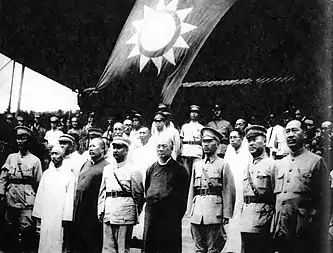
The Kuomintang used traditional Chinese religious ceremonies, the souls of Party martyrs who died fighting for the Kuomintang and the revolution and the party founder Dr. Sun Yatsen were sent to heaven according to the Kuomintang party. Chiang Kaishek believed that these martyrs witnessed events on earth from heaven.[48][49][50][51]
When the Northern Expedition was complete, Kuomintang Generals led by Chiang Kaishek paid tribute to Dr. Sun's soul in heaven with a sacrificial ceremony at the Xiangshan Temple in Beijing in July 1928, among the Kuomintang Generals present were the Muslim Generals Bai Chongxi and Ma Fuxiang.[52]
The Kuomintang backed the New Life Movement, which promoted Confucianism, and it was also against westernization.
The Kuomintang leaders also opposed the May Fourth Movement. Chiang Kai-shek, as a nationalist, and Confucianist, was against the iconoclasm of the May Fourth Movement. He viewed some western ideas as foreign, as a Chinese nationalist, and that the introduction of western ideas and literature that the May Fourth Movement wanted was not welcome. He and Dr. Sun Yat-sen criticized these May Fourth intellectuals for corrupting morals of youth.[53]
Imams sponsored by the Kuomintang called for Muslims to go on Jihad to become shaheed (Muslim term for martyr) in battle, where Muslims believed they would go automatically to heaven. Becoming a shaheed in the Jihad for the country was encouraged by the Kuomintang, which was called "glorious death for the state" and a hadith promoting nationalism was spread.[54] A song written by Xue Wenbo at the Muslim Chengda school, which was controlled by the Kuomintang, called for martyrdom in battle for China against Japan.[55]
The Kuomintang also incorporated Confucianism in its jurisprudence. It pardoned Shi Jianqiao for murdering Sun Chuanfang, because she did it in revenge since Sun executed her father Shi Congbin, which was an example of Filial piety to one's parents in Confucianism.[56] The Kuomintang encouraged filial revenge killings and extended pardons to those who performed them.[57]
Modernization
Historians until the 1990s often portrayed the KMT simply as a band of corrupt leaders who colluded with rich financiers and industrialists and cared little for China's workers and peasants, contrasting it with the supposed broad base of popular support for the communists. However, as Bodenhorn (2002) shows, scholars are coming to an appreciation of its efforts to build a vibrant and dynamic state, before it lost on the battlefield to the Communists, but then had a second chance on Taiwan where they did succeed.[58]
The KMT promoted science and industry, and tried to eradicate such traditional practices as footbinding, and extravagant marriage and funerary customs. The KMT had a complicated relationship to Christian missionary activity. Many high officials (including Chiang) were Christians and American public opinion that favored China was based on the missionaries. At the same time in the villages the KMT criticized missionary activity as an egregious example of imperialism. No significant action against the churches was taken but criticizing them was a much safer way to spread the anti-imperialist message of the KMT than taking on foreign firms or the U.S. The anti-Christian movements were important tactically for gaining the support of students and others in society who were angry at the influence of outsiders in China.
The Kuomintang purged China's education system of western ideas, introducing Confucianism into the curriculum. Education came under the total control of state, which meant, in effect, the Kuomintang party, via the Ministry of Education. Military and political classes on the Kuomintang's Three principles of the people were added. Textbooks, exams, degrees and educational instructors were all controlled by the state, as were all universities.[59]
Soviet style military
Chiang Ching-kuo, appointed as Kuomintang director of Secret Police in 1950, was educated in the Soviet Union, and initiated Soviet style military organization in the Republic of China Military, reorganizing and Sovietizing the political officer corps, surveillance, and Kuomintang party activities were propagated throughout the military. Opposed to this was Sun Li-jen, who was educated at the American Virginia Military Institute.[60] Chiang Ching-kuo then arrested Sun Li-jen, charging him of conspiring with the American CIA of plotting to overthrow Chiang Kai-shek and the Kuomintang, Sun was placed under house arrest in 1955.[61][62]
KMT in Taiwan
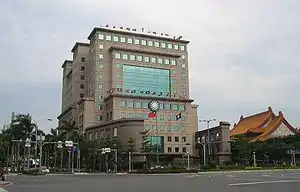
In 1895, Taiwan, including the Pescadores, became a Japanese colony, a concession by the Qing Empire after it lost the First Sino-Japanese War. After Japan's defeat at the end of World War II in 1945, General Order No. 1 instructed Japan, who surrendered to the US, to surrender its troops in Taiwan to the forces of the Republic of China Kuomintang.
Taiwan was placed under the administrative control of the Republic of China by the United Nations Relief and Rehabilitation Administration (UNRRA), and the ROC put Taiwan under military occupation. Tensions between the local Taiwanese and mainlanders from mainland China increased in the intervening years culminating in a flashpoint on 27 February 1947 in Taipei when a dispute between a female cigarette vendor and an anti-smuggling officer triggered civil disorder and protests that would last for days. The uprising turned bloody and was shortly put down by the ROC Army in the February 28 Incident.
Following the establishment of the People's Republic of China (PRC) on 1 October 1949, the commanders of the PRC People's Liberation Army believed that Kinmen and Matsu had to be taken before a final assault on Taiwan. KMT fought the Battle of Kuningtou and stopped the invasion. In 1950 Chiang took office in Taipei under the Temporary Provisions Effective During the Period of Communist Rebellion. The provision declared martial law in Taiwan and halted some democratic processes, including presidential and parliamentary elections, until the mainland could be recovered from the Communists. KMT estimated it would take 3 years to defeat the Communists. The slogan was "prepare in the first year, start fighting in the second, and conquer in the third year." However, various factors, including international pressure, are believed to have prevented the KMT from militarily engaging the Communists full-scale. A cold war with a couple of minor military conflicts was resulted in the early years. The various government bodies previously in Nanjing were re-established in Taipei as the KMT-controlled government actively claimed sovereignty over all China. The Republic of China in Taiwan retained China's seat in the United Nations until 1971 . Until the 1970s, KMT successfully pushed ahead with land reforms, developed the economy, implemented a democratic system in a lower level of the government, improved cross-Taiwan Strait relations, and created the Taiwan economic miracle. However KMT controlled the government under a one-party authoritarian state until reforms in the late 1970s through the 1990s. As a result of the February 28 Incident in 1947, Taiwanese people had to endure what is called the "White Terror", a KMT-led political repression. The ROC in Taiwan was once referred to synonymously with the KMT and known simply as "Nationalist China" after its ruling party. In the 1970s, the KMT began to allow for "supplemental elections" in Taiwan to fill the seats of the aging representatives in parliament. Although opposition parties were not permitted, Tangwai (or, "outside the party") representatives were tolerated. In the 1980s, the KMT focused on transforming the government from a one-party system to a multi-party democracy one and embracing "Taiwanizing". With the founding of the Democratic Progressive Party (DPP) in 1986, the KMT started competing against the DPP in Parliamentary elections. In 1991, martial law ceased when President Lee Teng-Hui terminated the Temporary Provisions Effective During the Period of Communist Rebellion. All parties started to be allowed to compete at all levels of elections, including the presidential election. Lee Teng-hui, the ROC's first democratically elected President and the leader of the KMT during the 1990s, announced his advocacy of "special state-to-state relations" with the PRC. The PRC associated it with Taiwan independence.
The KMT faced a split in 1994 that led to the formation of the Chinese New Party, alleged to be a result of Lee's "corruptive ruling style". The New Party has, since the purging of Lee, largely reintegrated into KMT. A much more serious split in the party occurred as a result of the 2000 Presidential election. Upset at the choice of Lien Chan as the party's presidential nominee, former party Secretary-General James Soong launched an independent bid, which resulted in the expulsion of Soong and his supporters and the formation of the People's First Party (PFP). The KMT candidate placed third behind Soong in the elections. After the election, Lee's strong relationship with the opponent became apparent. In order to prevent defections to the PFP, Lien moved the party away from Lee's pro-independence policies and became more favorable toward Chinese reunification. This shift led to Lee's expulsion from the party and the formation of the Taiwan Solidarity Union.
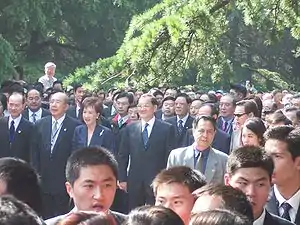
As the ruling party on Taiwan, the KMT amassed a vast business empire of banks, investment companies, petrochemical firms, and television and radio stations, thought to have made it the world's richest political party, with assets once estimated to be around US$2–10 billion.[63] Although this war chest appeared to help the KMT until the mid-1990s, it later led to accusations of corruption (see Black gold (politics)). After 2000, the KMT's financial holdings appeared to be more of a liability than a benefit, and the KMT started to divest its assets. However, the transactions were not disclosed and the whereabouts of the money earned from selling assets (if it has gone anywhere) is unknown. There were accusations in the 2004 presidential election that the KMT retained assets that were illegally acquired. Currently, there is a law proposed by the DPP in the Legislative Yuan to recover illegally acquired party assets and return them to the government; however, since the pan-Blue alliance, the KMT and its smaller partner PFP, control the legislature, it is very unlikely to be passed. The KMT also acknowledged that part of its assets were acquired through extra-legal means and thus promised to "retro-endow" them to the government. However, the quantity of the assets which should be classified as illegal are still under heated debate; DPP, in its capacity as ruling party from 2000–2008, claimed that there is much more that the KMT has yet to acknowledge. Also, the KMT actively sold assets under its title in order to quench its recent financial difficulties, which the DPP argues is illegal. Former KMT Chairman Ma Ying-Jeou's position is that the KMT will sell some of its properties at below market rates rather than return them to the government and that the details of these transactions will not be publicly disclosed.
In December 2003, then-KMT chairman (present chairman emeritus) and presidential candidate Lien Chan initiated what appeared to some to be a major shift in the party's position on the linked questions of Chinese reunification and Taiwan independence. Speaking to foreign journalists, Lien said that while the KMT was opposed to "immediate independence," it did not wish to be classed as "pro-reunificationist" either.
At the same time, Wang Jin-pyng, speaker of the Legislative Yuan and the Pan-Blue Coalition's campaign manager in the 2004 presidential election, said that the party no longer opposed Taiwan's "eventual independence." This statement was later clarified as meaning that the KMT opposes any immediate decision on unification and independence and would like to have this issue resolved by future generations. The KMT's position on the cross-strait relationship was redefined as hoping to remain in the current neither-independent-nor-united situation.
.jpg.webp)
In 2005, then-party chairman Lien Chan announced that he was to leave his office. The two leading contenders for the position include Ma Ying-jeou and Wang Jin-pyng. On 5 April 2005, Taipei Mayor Ma Ying-jeou said he wished to lead the opposition Kuomintang with Wang Jin-pyng. On 16 July 2005, Ma was elected as KMT chairman in the first contested leadership in Kuomintang's 93-year history. Some 54 percent of the party's 1.04 million members cast their ballots. Ma Ying-jeou garnered 72.4 percent of vote share, or 375,056 votes, against Wang Jin-pyng's 27.6 percent, or 143,268 votes. After failing to convince Wang to stay on as a vice chairman, Ma named holdovers Wu Po-hsiung (吳伯雄), Chiang Pin-kung (江丙坤), and Lin Cheng-chi (林澄枝), as well as long-time party administrator and strategist John Kuan (關中), as vice-chairmen; all appointments were approved by a hand count of party delegates.
There has been a recent warming of relations between the pan-blue coalition and the PRC, with prominent members of both the KMT and PFP in active discussions with officials on the Mainland. In February 2004, it appeared that KMT had opened a campaign office for the Lien-Soong ticket in Shanghai targeting Taiwanese businessmen. However, after an adverse reaction in Taiwan, the KMT quickly declared that the office was opened without official knowledge or authorization. In addition, the PRC issued a statement forbidding open campaigning in the Mainland and formally stated that it had no preference as to which candidate won and cared only about the positions of the winning candidate.
On 28 March 2005, thirty members of the Kuomintang (KMT), led by KMT vice chairman Chiang Pin-kung, arrived in mainland China. This marked the first official visit by the KMT to the mainland since it was defeated by communist forces in 1949 (although KMT members including Chiang had made individual visits in the past). The delegates began their itinerary by paying homage to the revolutionary martyrs of the Tenth Uprising at Huanghuagang. They subsequently flew to the former ROC capital of Nanjing to commemorate Sun Yat-sen. During the trip KMT signed a 10-points agreement with the CPC. The opponents regarded this visit as the prelude of the third KMT-CPC cooperation. Weeks afterwards, in May, Chairman Lien Chan visited the mainland and met with Hu Jintao. No agreements were signed because Chen Shui-bian's government threatened to prosecute the KMT delegation for treason and violation of R.O.C. laws prohibiting citizens from collaborating with Communists.
On 13 February 2007, Ma was indicted by the Taiwan High Prosecutors Office on charges of allegedly embezzling approximately NT$11 million (US$339,000), regarding the issue of "special expenses" while he was mayor of Taipei. Shortly after the indictment, he submitted his resignation as chairman of the Kuomintang at the same press conference at which he formally announced his candidacy for President. Ma argued that it was customary for officials to use the special expense fund for personal expenses undertaken in the course of their official duties. In December 2007, Ma was acquitted of all charges and immediately filed suit against the prosecutors who are also appealing the acquittal.
In 2020 the 48 year old Johnny Chiang was elected chair of the Kuomintang. He replaced Wu Den-yih who resigned due to the party’s defeat in the January elections. Chiang faced challenges both with managing the KMT’s history and from a variety of structural problems within the party.[64]
Leaders
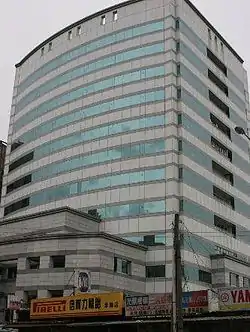
.JPG.webp)
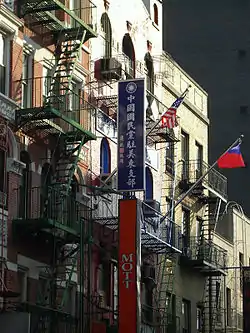
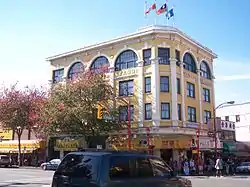
References
- The event is also known as the Shanghai Massacre of 1927. See Tien-wei Wu, "A Review of the Wuhan Debacle: the Kuomintang-Communist Split of 1927." Journal of Asian Studies 1969 29(1): 125–143
- Strand 2002 59–60
- Jonathan Fenby (2005). Chiang Kai Shek: China's Generalissimo and the Nation He Lost. Carroll & Graf Publishers. p. 504. ISBN 0786714840. Retrieved 2010-06-28.
- Edgar Snow (2008). Red Star Over China – The Rise of the Red Army. READ BOOKS. p. 89. ISBN 978-1443736732. Retrieved 2010-06-28.
- Jieru Chen; Lloyd E. Eastman (1993). Chiang Kai-shek's secret past: the memoir of his second wife, Chʻen Chieh-ju. Westview Press. p. 19. ISBN 0813318254. Retrieved 2010-06-28.
Dear Ah Feng, the Chinese Revolution is yet to be completed. But I, a revolutionary, feel down-hearted and am unable to devote my full energy to our country. I only want you to promise me one thing and then I shall find strength again to work hard for the revolution.
- Kai-shek Chiang (1947). Philip Jacob Jaffe (ed.). China's destiny & Chinese economic theory. Roy Publishers. p. 225. Retrieved 2010-06-28.
- Simei Qing (2007). From allies to enemies: visions of modernity, identity, and U.S.-China diplomacy, 1945–1960. Harvard University Press. p. 65. ISBN 978-0674023444. Retrieved 2010-06-28.
- Kai Shew Chiang Kai Shew (2007). China's Destiny and Chinese Economic Theory. READ BOOKS. p. 225. ISBN 978-1406758382. Retrieved 2010-06-28.
- Hongshan Li; Zhaohui Hong (1998). Image, perception, and the making of U.S.-China relations. University Press of America. p. 268. ISBN 0761811583. Retrieved 2010-06-28.
- Jieru Chen; Lloyd E. Eastman (1993). Chiang Kai-shek's secret past: the memoir of his second wife, Chʻen Chieh-ju. Westview Press. p. 226. ISBN 0813318254. Retrieved 2010-06-28.
see his face was livid and his hands were shaking – he ran amok. He swept things off the table and broke the furniture by smashing chairs and overturning tables. Then, like a baby, he broke down and wept bitterly. All that afternoon and evening, he refused to.
- Uradyn Erden Bulag (2002). Dilemmas The Mongols at China's edge: history and the politics of national unity. Rowman & Littlefield. p. 50. ISBN 0742511448. Retrieved 2010-06-28.
- Jonathan Fenby (2005). Chiang Kai Shek: China's Generalissimo and the Nation He Lost. Carroll & Graf Publishers. p. 413. ISBN 0786714840. Retrieved 2010-06-28.
- Hongshan Li; Zhaohui Hong (1998). Image, perception, and the making of U.S.-China relations. University Press of America. p. 268. ISBN 0761811583. Retrieved 2010-06-28.
- Frederic E. Wakeman (2003). Spymaster: Dai Li and the Chinese secret service. University of California Press. p. 75. ISBN 0520234073. Retrieved 2010-06-28.
- Jonathan Fenby (2005). Chiang Kai Shek: China's Generalissimo and the Nation He Lost. Carroll & Graf Publishers. p. 414. ISBN 0786714840. Retrieved 2010-06-28.
- Uradyn Erden Bulag (2002). Dilemmas The Mongols at China's edge: history and the politics of national unity. Rowman & Littlefield. p. 48. ISBN 0742511448. Retrieved 2010-06-28.
- Uradyn Erden Bulag (2002). Dilemmas The Mongols at China's edge: history and the politics of national unity. Rowman & Littlefield. p. 49. ISBN 0742511448. Retrieved 2010-06-28.
- The new Orient; a series of monographs on Oriental culture ... 1933. p. 116. Retrieved 2011-05-29.
- Paul Carus, ed. (1934). The Open court, Volume 47. The Open Court Pub. Co. p. 116. Retrieved 2011-05-29.
- Owen Lattimore (1962). Frontier history. Oxford University Press. p. 197. Retrieved 2011-05-29.
- Douglas Kerr (2009). Critical Zone 3: A Forum of Chinese and Western Knowledge. Hong Kong University Press. p. 151. ISBN 978-9622098572. Retrieved 2010-06-28.
- Jonathan Fenby (2005). Chiang Kai Shek: China's Generalissimo and the Nation He Lost. Carroll & Graf Publishers. p. 126. ISBN 0786714840. Retrieved 2010-06-28.
- Diana Lary (1974). Region and nation: the Kwangsi clique in Chinese politics, 1925–1937. Cambridge University Press. p. 98. ISBN 0521202043. Retrieved 2010-06-28.
- Don Alvin Pittman (2001). Toward a modern Chinese Buddhism: Taixu's reforms. University of Hawaii Press. p. 146. ISBN 0-8248-2231-5. Retrieved 2010-06-28.
- Diana Lary (1974). Region and nation: the Kwangsi clique in Chinese politics, 1925–1937. Cambridge University Press. p. 99. ISBN 0521202043. Retrieved 2010-06-28.
- Diana Lary (1974). Region and nation: the Kwangsi clique in Chinese politics, 1925–1937. Cambridge University Press. p. 99. ISBN 0521202043. Retrieved 2010-06-28.
- Diana Lary (1974). Region and nation: the Kwangsi clique in Chinese politics, 1925–1937. Cambridge University Press. p. 100. ISBN 0521202043. Retrieved 2010-06-28.
- Diana Lary (1974). Region and nation: the Kwangsi clique in Chinese politics, 1925–1937. Cambridge University Press. p. 124. ISBN 0521202043. Retrieved 2010-06-28.
- Uradyn Erden Bulag (2002). Dilemmas The Mongols at China's edge: history and the politics of national unity. Rowman & Littlefield. p. 54. ISBN 0742511448. Retrieved 2010-06-28.
- BARRY RUBIN (2000). Guide to Islamist Movements. M.E. Sharpe. p. 79. ISBN 0765617471. Retrieved 2010-06-28.
- Arif Dirlik (2005). The Marxism in the Chinese revolution. Rowman & Littlefield. p. 20. ISBN 0742530698. Retrieved 2010-06-28.
- Von KleinSmid Institute of International Affairs, University of Southern California. School of Politics and International Relations (1988). Studies in comparative communism, Volume 21. Butterworth-Heinemann. p. 134. Retrieved 2010-06-28.
- Hannah Pakula (2009). The last empress: Madame Chiang Kai-Shek and the birth of modern China. Simon and Schuster. p. 346. ISBN 978-1439148938. Retrieved 2010-06-28.
chiang was then known as the red general movies.
- Jay Taylor (2000). The Generalissimo's son: Chiang Ching-kuo and the revolutions in China and Taiwan. Harvard University Press. p. 42. ISBN 0674002873. Retrieved 2010-06-28.
- Jonathan Fenby (2005). Chiang Kai Shek: China's Generalissimo and the Nation He Lost. Carroll & Graf Publishers. p. 71. ISBN 0786714840. Retrieved 2010-06-28.
- Hannah Pakula (2009). The last empress: Madame Chiang Kai-Shek and the birth of modern China. Simon and Schuster. p. 128. ISBN 978-1439148938. Retrieved 2010-06-28.
merchants levy taxes.
- Jonathan Fenby (2005). Chiang Kai Shek: China's Generalissimo and the Nation He Lost. Carroll & Graf Publishers. p. 71. ISBN 0786714840. Retrieved 2010-06-28.
- Hannah Pakula (2009). The last empress: Madame Chiang Kai-Shek and the birth of modern China. Simon and Schuster. p. 128. ISBN 978-1439148938. Retrieved 2010-06-28.
customs surplus merchants levy taxes.
- Jonathan Fenby (2005). Chiang Kai Shek: China's Generalissimo and the Nation He Lost. Carroll & Graf Publishers. p. 72. ISBN 0786714840. Retrieved 2010-06-28.
- Jonathan Fenby (2005). Chiang Kai Shek: China's Generalissimo and the Nation He Lost. Carroll & Graf Publishers. p. 73. ISBN 0786714840. Retrieved 2010-06-28.
- Jonathan Fenby (2005). Chiang Kai Shek: China's Generalissimo and the Nation He Lost. Carroll & Graf Publishers. p. 485. ISBN 0786714840. Retrieved 2010-06-28.
- Jonathan Fenby (2005). Chiang Kai Shek: China's Generalissimo and the Nation He Lost. Carroll & Graf Publishers. p. 486. ISBN 0786714840. Retrieved 2010-06-28.
- Simei Qing "From Allies to Enemies", 19
- A. Doak Barnett (1968). China on the eve of Communist takeover. Praeger. p. 190. Retrieved 2010-06-28.
- John Roderick (1993). Covering China: the story of an American reporter from revolutionary days to the Deng era. Imprint Publications. p. 104. ISBN 1879176173. Retrieved 2010-06-28.
- Werner Draguhn; David S. G. Goodman (2002). China's communist revolutions: fifty years of the People's Republic of China. Psychology Press. p. 38. ISBN 0700716300. Retrieved 2011-04-09.
- T. J. Byres; Harbans Mukhia (1985). Feudalism and non-European societies. Psychology Press. p. 207. ISBN 0714632457. Retrieved 2010-11-28.
- Jieru Chen; Lloyd E. Eastman (1993). Chiang Kai-shek's secret past: the memoir of his second wife, Chʻen Chieh-ju. Westview Press. p. 236. ISBN 0813318254. Retrieved 2010-06-28.
party martyrs heaven.
- Hans J. Van de Ven (2003). War and nationalism in China, 1925–1945. Psychology Press. p. 100. ISBN 0415145716. Retrieved 2010-06-28.
- Linda Chao; Ramon H. Myers (1998). The first Chinese democracy: political life in the Republic of China on Taiwan. Johns Hopkins University Press. p. 45. ISBN 0801856507. Retrieved 2010-06-28.
- Kai-shek Chiang (1946). President Chiang Kai-shek's selected speeches and messages, 1937–1945. China Cultural Service. p. 137. Retrieved 2010-06-28.
- Hsiao-ting Lin (2006). Tibet and nationalist China's frontier: intrigues and ethnopolitics, 1928–49 (PDF). UBC Press. p. 29. ISBN 0774813016. Archived from the original (PDF) on 2011-05-13. Retrieved 2010-06-28.
- Joseph T. Chen (1971). The May fourth movement in Shanghai: the making of a social movement in modern China. Brill Archive. p. 13. Retrieved 2010-06-28.
- Stéphane A. Dudoignon; Hisao Komatsu; Yasushi Kosugi (2006). Intellectuals in the modern Islamic world: transmission, transformation, communication. Taylor & Francis. p. 135. ISBN 978-0-415-36835-3. Retrieved 2010-06-28.
- Stéphane A. Dudoignon; Hisao Komatsu; Yasushi Kosugi (2006). Intellectuals in the modern Islamic world: transmission, transformation, communication. Taylor & Francis. p. 135. ISBN 978-0-415-36835-3. Retrieved 2010-06-28.
- Eugenia Lean (2007). Public passions: the trial of Shi Jianqiao and the rise of popular sympathy in Republican China. University of California Press. p. 148. ISBN 978-0520247185. Retrieved 2010-06-28.
- Eugenia Lean (2007). Public passions: the trial of Shi Jianqiao and the rise of popular sympathy in Republican China. University of California Press. p. 150. ISBN 978-0520247185. Retrieved 2010-06-28.
- Terry Bodenhorn, ed. Defining Modernity: Guomindang Rhetorics of a New China, 1920–1970 (2002)
- Werner Draguhn; David S. G. Goodman (2002). China's communist revolutions: fifty years of the People's Republic of China. Psychology Press. p. 39. ISBN 0700716300. Retrieved 2011-04-09.
- Jay Taylor (2000). The Generalissimo's son: Chiang Ching-kuo and the revolutions in China and Taiwan. Harvard University Press. p. 195. ISBN 0674002873. Retrieved 2010-06-28.
- Peter R. Moody (1977). Opposition and dissent in contemporary China. Hoover Press. p. 302. ISBN 0817967710. Retrieved 2010-11-30.
- Nancy Bernkopf Tucker (1983). Patterns in the dust: Chinese-American relations and the recognition controversy, 1949–1950. Columbia University Press. p. 181. ISBN 0231053622. Retrieved 2010-06-28.
- "Taiwan's Kuomintang On the brink". Economist. 6 Dec 2001.
- "Taiwan's once-powerful Kuomintang faces make-or-break moment". mainichi.jp. Mainichi. Retrieved 22 April 2020.
Sources
- Strand, David (2002). "Chapter 2:Citizens in the Audience and at the Podium". In Goldman, Merle; Perry, Elizabeth (eds.). Changing Meanings of Citizenship in Modern China. Cambridge, Massachusetts, United States: Harvard University Press. pp. 59–60. ISBN 978-0-674-00766-6. Retrieved 2011-02-19.
Further reading
- Barnett, A. Doak China on the Eve of Communist Takeover. Praeger, 1963 online edition
- Bedeski, Robert E. State-Building in Modern China: The Kuomintang in the Prewar Period. (1981). 181 pp.
- Bergere, Marie-Claire. Sun Yat-Sen (1998), 480pp, the standard biography
- Bodenhorn, Terry, ed. Defining Modernity: Guomindang Rhetorics of a New China, 1920–1970. (2002). 288 pp. ISBN 0-89264-161-4
- Boorman, Howard L., ed. Biographical Dictionary of Republican China. (Vol. I-IV and Index. 1967–1979). 600 short scholarly biographies excerpt and text search
- Botjer, George. A Short History of Nationalist China, 1919–1949 (1979). 312pp
- Fairbank, John K., ed. The Cambridge History of China, Vol. 12, Republican China 1912–1949. Part 1. Cambridge U. Press, 1983. 1001 pp.
- Fairbank, John K. and Feuerwerker, Albert, eds. The Cambridge History of China. Vol. 13: Republican China, 1912–1949, Part 2. Cambridge U. Press, 1986. 1092 pp.
- Fenby, Jonathan. Chiang Kai Shek: China's Generalissimo and the Nation He Lost (2004), 592pp excerpt and text search
- Hille, Kathrin. "Resurgent KMT must confront its dark past," Financial Times 6 December 2007 online
- Hood, Steven J. The Kuomintang and the Democratization of Taiwan. Westview, 1997. 181 pp. online from Questia
- Hsiung, James C. and Steven I. Levine. China's Bitter Victory: The War with Japan, 1937–1945 (1992) online from Questia
- Nedostop, Rebecca. "Two Tombs: Thoughts on Zhu Yuanzhang, the Kuomintang, and the Meaning of National Heroes." Chap. 17 in Long Live the Emperor! Uses of the Ming Founder across Six Centuries of East Asian History, ed. Sarah Schneewind, 355–90. Minneapolis: Society for Ming Studies, 2008. ISBN 9780980063905.
- Perleberg, Max. Who's Who in Modern China (From the Beginning of the Chinese Republic to the End of 1953): Over Two Thousand Detailed Biographies of the Most Important Men Who Took Part in the Great Struggle for China, Including Detailed Histories of the Political Parties, Government Organisations, a Glossary of New Terms Used in Contemporary Chinese (1954) online from Questia
- Pye, Lucian W. Warlord Politics: Conflict and Coalition in the Modernization of Republican China (1971) online from Questia
- Rigger, Shelley. Politics in Taiwan: Voting for Democracy (1999) online edition
- Sharman, Lyon. Sun Yat-Sen His Life and Its Meaning: A Critical Biography. (1968) online from Questia
- Spence, Jonathan D. The Search for Modern China (1991), 876pp; well written survey from 1644 to 1980s excerpt and text search; complete edition online at Questia
- Taylor, Jay. The Generalissimo: Chiang Kai-shek and the Struggle for Modern China (2011) excerpt and text search
- Taylor, Jay. The Generalissimo's Son: Chiang Ching-kuo and the Revolutions in China and Taiwan. (2000). 496 pp.
- Thornton, Richard C. China: A Political History, 1917–1980 (1982) online edition
- Wachman, Alan M. Taiwan: National Identity and Democratization (1994) online edition
- Yu, George T. Party Politics in Republican China the Kuomintang, 1912– 1924 (1966) online from Questia
- Zanasi, Margherita. Saving the Nation: Economic Modernity in Republican China. U. of Chicago Press, 2006. 320 pp.
